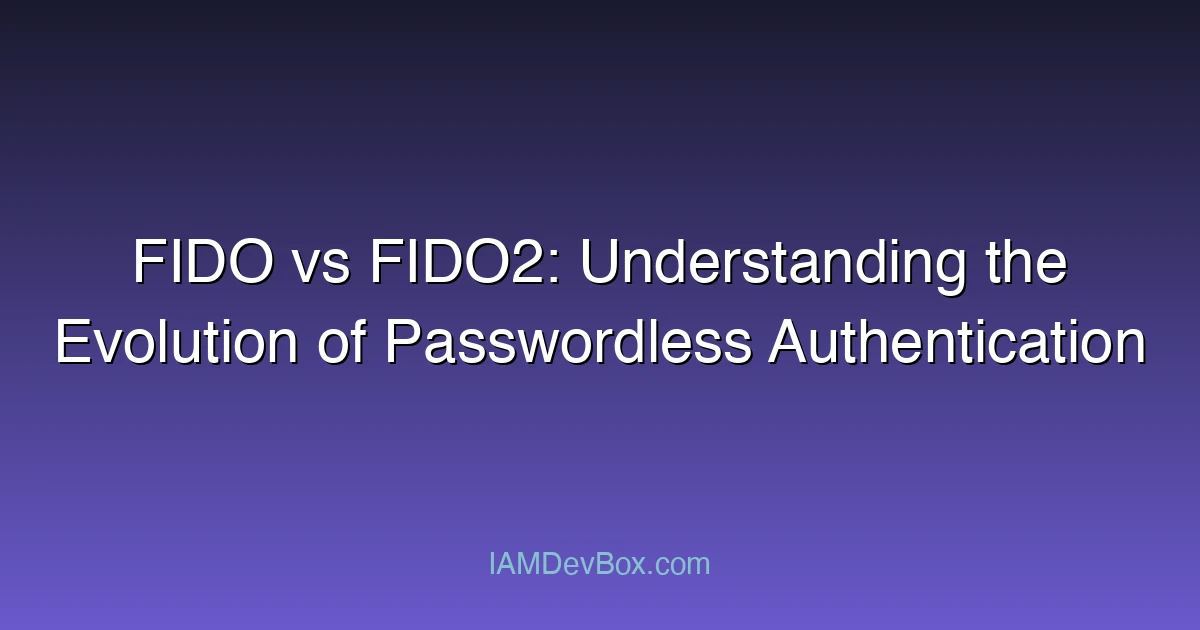Visual Overview:
graph TB
subgraph "Authentication Methods"
Auth[Authentication] --> Password[Password]
Auth --> MFA[Multi-Factor]
Auth --> Passwordless[Passwordless]
MFA --> TOTP[TOTP]
MFA --> SMS[SMS OTP]
MFA --> Push[Push Notification]
Passwordless --> FIDO2[FIDO2/WebAuthn]
Passwordless --> Biometric[Biometrics]
Passwordless --> Magic[Magic Link]
end
style Auth fill:#667eea,color:#fff
style MFA fill:#764ba2,color:#fff
style Passwordless fill:#4caf50,color:#fff
Introduction
As organizations and developers continue shifting toward passwordless authentication, two standards often come up: FIDO and FIDO2. While closely related, these standards represent different stages in the evolution of secure, phishing-resistant login technology.
This article explains the technical and strategic differences between FIDO (U2F) and FIDO2, their roles in modern authentication, and how to choose the right standard for your app or enterprise environment.
What Is FIDO?
FIDO (Fast IDentity Online) originally referred to a family of open standards developed by the FIDO Alliance to improve authentication security through:
- U2F (Universal 2nd Factor): A standard introduced by Google and Yubico.
- Use Case: Typically used as a second factor after username/password login.
FIDO (U2F) works by allowing a hardware authenticator (like a YubiKey) to register with a web service and provide cryptographic challenge-response validation.
U2F Authentication Flow
flowchart LR
A["User Login"] --> B["Enter username/password"]
B --> C["Tap security key"]
C --> D["Key signs server challenge"]
D --> E["Server verifies using public key"]
style A fill:#667eea,color:#fff
style C fill:#ed8936,color:#fff
style E fill:#4caf50,color:#fff
- Works only with USB security keys
- Requires browser extensions or platform support
- Limited user verification capabilities
What Is FIDO2?
FIDO2 is the modern evolution of the original FIDO standard. It consists of two key components:
- WebAuthn — A W3C standard supported in modern browsers
- CTAP2 — A protocol for authenticators (hardware or platform-based) to communicate with the client device
With FIDO2, you can implement first-factor, passwordless authentication—no passwords or SMS codes needed.
FIDO2 Advantages
- Platform authenticator support (e.g., FaceID, fingerprint)
- Built-in browser API (WebAuthn)
- Strong user verification (biometrics, PINs)
- Phishing-resistant authentication
- Scalable across devices and OSes
FIDO2 Login Flow (Passwordless)
flowchart LR
A["User"] --> B["Click 'Login with Device'"]
B --> C["Biometric verification<br/>(Touch ID, Face ID)"]
C --> D["Device signs challenge<br/>with private key"]
D --> E["Server validates signature"]
style A fill:#667eea,color:#fff
style C fill:#764ba2,color:#fff
style E fill:#4caf50,color:#fff
FIDO vs. FIDO2: Key Differences
| Feature | FIDO (U2F) | FIDO2 |
|---|---|---|
| Authenticator Types | External hardware only | Hardware + built-in (biometric) |
| Browser Support | Limited | Widely supported (Chrome, Edge, etc.) |
| User Verification | Not supported (2nd factor) | Supported (biometrics, PINs) |
| WebAuthn Integration | ❌ No | ✅ Yes |
| Passwordless Login | ❌ No | ✅ Yes |
| Use Case | MFA | Primary or MFA login |
Why FIDO2 Matters in 2025
The shift from FIDO (U2F) to FIDO2 is driven by modern security and UX needs:
- Phishing resistance is mandatory for high-risk sectors (finance, healthcare, government).
- User convenience demands biometric or device-based login.
- Regulatory pressure (NIST, eIDAS, PSD2) favors stronger identity assurance.
- Cross-platform support: Android, iOS, Windows Hello, macOS all support FIDO2.
Should I Still Use FIDO (U2F)?
You might consider FIDO (U2F) in legacy systems or when:
- Your users already use USB-only hardware keys
- Your application is not browser-based (e.g., legacy desktop apps)
- Your identity provider supports only U2F (rare in 2025)
However, for new systems, FIDO2 is the recommended baseline.
Integration Notes for Developers
FIDO2 in Web Apps (JavaScript Sample)
const publicKey = {
challenge: new Uint8Array([/* random bytes */]),
rp: { name: "IAMDevBox" },
user: {
id: new Uint8Array(16),
name: "[email protected]",
displayName: "User Example"
},
pubKeyCredParams: [{ alg: -7, type: "public-key" }],
authenticatorSelection: { userVerification: "preferred" },
timeout: 60000,
attestation: "none"
};
navigator.credentials.create({ publicKey });
Identity Provider Support
- ForgeRock Identity Cloud: Offers drag-and-drop WebAuthn nodes for journeys.
- Azure AD: Enforces FIDO2 login policies for workforce and hybrid identities.
- Okta/Auth0: Supports FIDO2 and WebAuthn for both B2B and B2C login flows.
🎯 Key Takeaways
- U2F (Universal 2nd Factor)
- Requires browser extensions or platform support
- Limited user verification capabilities
Summary
- FIDO (U2F) was a game-changer for 2FA, but it’s now a legacy technology.
- FIDO2 is the current and future standard for passwordless, secure, scalable authentication.
- Embrace FIDO2 to stay compliant, protect against phishing, and offer seamless login experiences across platforms.
For modern web apps and enterprise systems, FIDO2 should be your default authentication strategy.
